-
Notifications
You must be signed in to change notification settings - Fork 0
User Guide
WRECK is primarily developed and tested on a Windows machine running Java 8. Newer Java versions should work without issues although they are untested.
In theory, WRECK should work with minimal rewriting or porting as a Java application. However, it uses 3rd party tools and libraries that consist of native codes and are not cross-platform in nature. Trying to run it on Linux or MacOS would require replacing these 3rd party software with their equivalence.
For other platforms and operating systems, they are not tested or guaranteed to work, thus they are not described here.
WRECK is a provided as a portable software. It does not require deep changes to your operating systems, and can be installed to any location you have write permission for.
The only exception is the required Java Runtime Environment (JRE) which is required to run WRECK and is usually installed as EXE or MSI installer package. This installer requires admin rights.
Advanced users may download and install JRE in a portable manner without admin rights. In this case, we need to download the JRE as a .zip or .tar.gz and install it manually. This process is not described here for simplicity.
- Download and install a Java Runtime Environment (JRE) 8 and above. You may use either the OpenJDK or Oracle JRE. (Optional)
- Download and install ExifTool to a preferred folder location. Use the Windows Executable package.
- Download and install MediaInfo to a preferred folder location. Use the Windows DLL package.
- Append the
PATHenvironment variable with the ExifTool and MediaInfo folder. - Download the latest version of WRECK as a ZIP from Github releases.
- Create a
Wreckshortcut inshell:sendtofolder. - Type
javaw -jar "<install-dir>\wreck-0.0.1-SNAPSHOT.jar"in Target - Click OK to close the shortcut Properties dialog box
- Delete the WRECK installation folder
- Edit
PATHenvironment variable to remove the ExifTool and MediaInfo folder. - Delete the MediaInfo folder.
- Delete the ExifTool folder.
- Remove Oracle JRE or OpenJDK from Windows Control Panel > Programs > Programs and Features
WRECK is designed to be used as a tool from file manager e.g. Windows Explorer / File Explorer.
- Select a file or folder
- Right-click > Send to > Wreck
The Settings tab presents all possible user actions.
The Files tab is only for reviewing fine-grained details about the time- shift delta corrections or changes for each file. This allows the user to review the impacts of their settings on the changes in timestamps used for corrections.
The About provides information and gives credits for the resources used.
WRECK is primarily designed to correct timestamps using metadata it is able to extract out of the files. Before we attempt to "correct" the timestamps of the file system attributes permanently, it may be wise to backup the existing timestamps for future cross-referencing even though they may already be inaccurate. The backup can also be used for restoration if our correction attempt results in too many inaccurate timestamps for our liking.
WRECK can backup the file system's timestamps to a Comma-Separated Value (CSV)
text file META_INF.CSV in the folder being corrected.
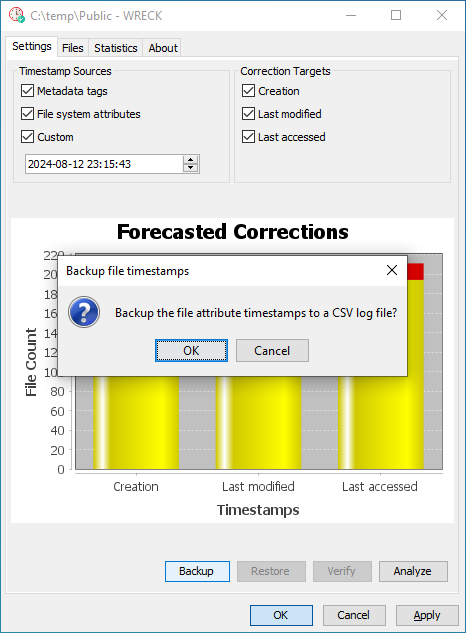
- Click Backup.
- Find
META_INF.CSVfile in folder. You can review it in Notepad, Microsoft Excel, LibreOffice Calc or any software supporting the CSV format.
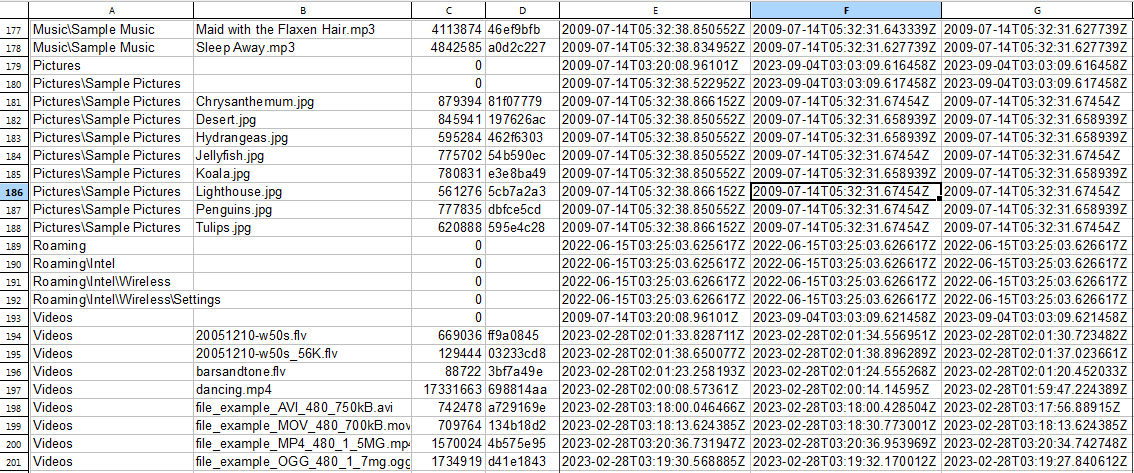
NOTE
The file name and location of the CSV file is fixed by convention for ease-of-use and cannot be overridden from within WRECK.
If a backup was done previously and a META_INF.CSV file exists, the
Restore button would be enabled.
If the Restore button is disabled, it implies no backup can be found.
IMPORTANT
A simplistic check for existence ofMETA_INF.CSVis done to determine if Restore function is available. Do not attempt to manually create an empty or malformedMETA_INF.CSVto force the enabling of Restore. Doing so may cause WRECK to crash or perform a partial restoration leaving the files in an indeterminate state.
WARN Once the timestamps are restored, the
META_INF.CSVbackup is deleted.
To restore the timestamps from a prior backup:
- Click Restore

With a backup created, we can verify if the selected file's or directory's Cyclic Redundency Check (CRC) matches those saved in the backup.
To verify a backup:
- Click Verify
- Review the bar chart for any error
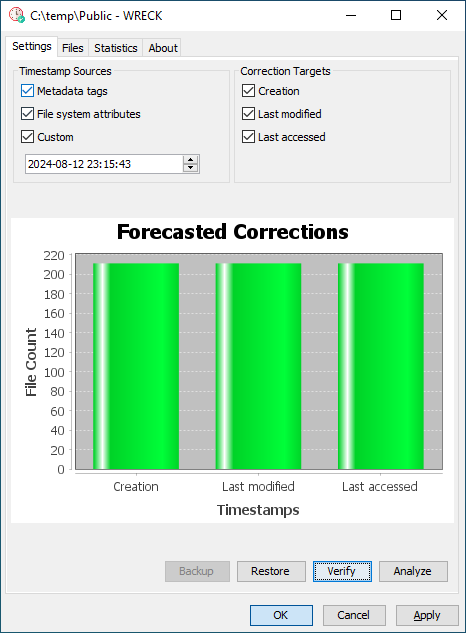
Use Analyze to preview the potential changes with the current settings without actually implementing them. This is useful when tweaking the ideal settings for maximizing the metadata extraction, choosing whether to reuse or ignore the present file system attribute timestamps, or selecting a custom user-specified date time limit.
In Settings tab,
- Click Analyze
- Review the bar chart for number of files affected for each file attribute
- Click Files tab to review the expected correction period for each file. This can be used to check on whether the metadata, inference rules and heuristics are providing valid and fairly accurate timestamps.
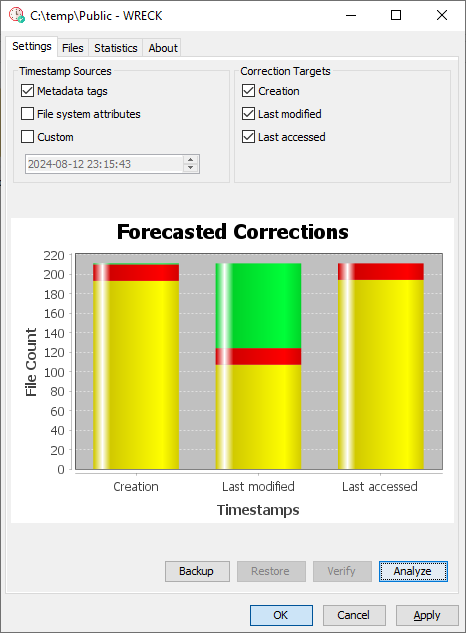
Note The bar chart uses colors for each attribute.
Color Description Green Number of files/folders already up-to-date and not requiring changes Amber Number of files/folders requiring correction based on metadata Red Number of files/folders with no useful metadata and thus uncorrectible The aim is to minimize the number of Red uncorrectible files due to absence of useful metadata with timestamps. Enabling the fallback options of File system attributes and Custom reduces the number of uncorrectible files.
Finally, we can repair, fix or correct the timestamps based on our chosen settings. This writes the suggested timestamps derived by WRECK from a combination of embedded metadata (if present), and the fallback file system attributes and a user-specified custom date time limit if they are enabled.
Before we implement the suggested corrections permanently, it may be advisable to backup the timestamps. We are also warned before the changes are made.
- Click OK or Apply to apply any corrections.
- Click OK to proceed with the changes, or Cancel to stop in the Confirmation dialog.
- Open Explorer and review the new file attribute timestamps for any discrepancies.
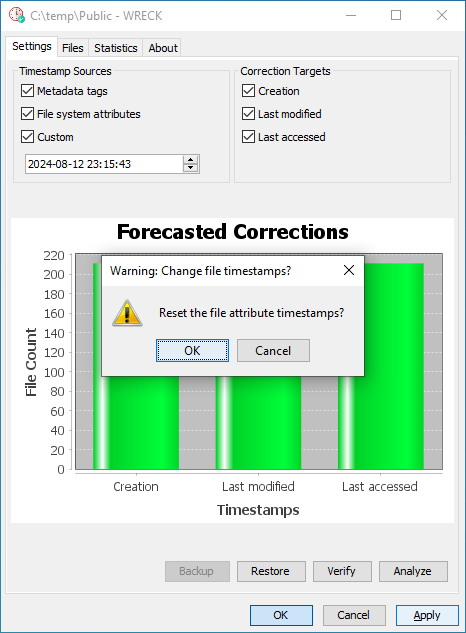
NOTE The only difference between OK and Apply is whether the dialog window closes when done. To keep the dialog window open to review the bar chart after it is done, choose Apply instead of OK.
The Files tab contains a list of corrections to applied or to be applied.

The correction is formatted in the YY-MM-DD format and color-coded to reflect
the direction of time change; a correction that shift the time backward is
colored in orange/amber, and any time forward is colored in red.
For example, a correction for a period of 1 year, 2 months and 3 days backward
is displayed as 01-02-03 in orange/amber. This indicates the present
file attribute timestamp is later than the correct one.
While a correction for a period of 4 years, 5 months and 6 days forward from
current timestamp is rendered as 04-05-06 in red. This indicates the present
file attribute timestamp is earlier than the correct one.
For files with timestamps that are already accurate and aligned with its metadata, the change will be blank/empty reflecting no change is required.
It is not possible at present to preview small corrections of less than a day as they are not significant enough to be highlighted. In many cases, the metadata values may differ from the ones on the file system by a few seconds or minutes even if they are correct due to the file I/O latency and caching. For simplicity, small time differences are ignored as a design decision.
After each operation (backup, verify, restore, apply, OK), the statistics for each operation are logged and summarized in Statistics tab
- Click Statistics tab
There are 3 types of statistics (corrections by file attribute, metadata tags, file types/extensions) and 3 types of views (table, bar, pie).
NOTE Pie chart can only visualize a single data series, unlike bar chart and table.
User can toggle the statistics and the view. Some examples are shown below.
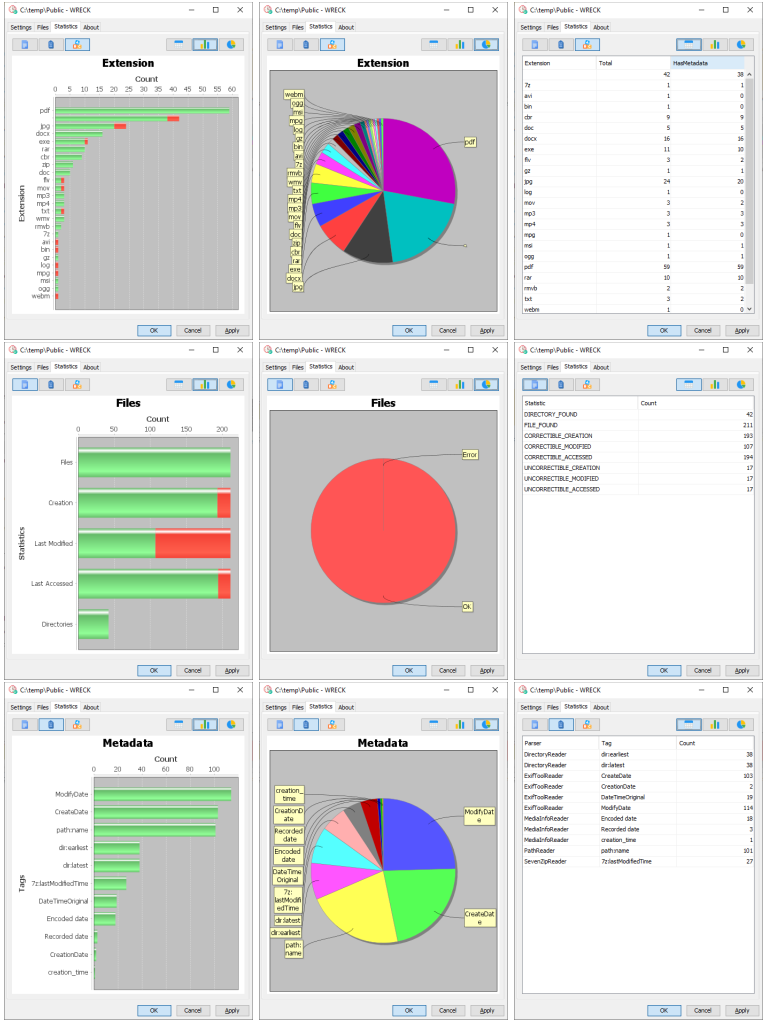
To view information on and credits to the software and icons used in WRECK:
- Click About tab.

Copyright (c) 2023 gyk4j. All Rights Reserved.